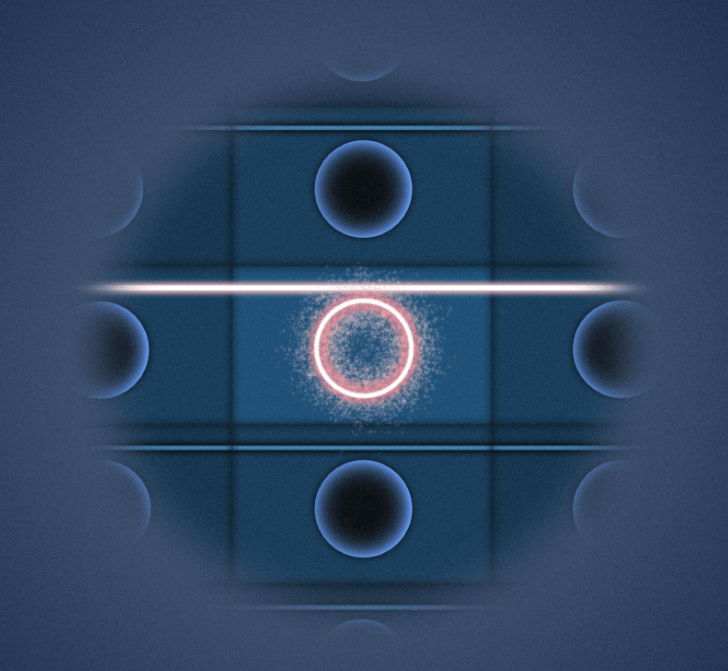By studying at the atomic scale the thermal behavior of nanoparticles composed of gold, cobalt, copper, nickel and platinum, scientists have revealed that the stability of these so-called high-entropy nanoalloys is much lower than expected, as gold and copper preferentially segregate on the surface of the nanostructures. These experimental and theoretical works question several structural properties predicted for this emerging nanoalloy family.

High-entropy nanoalloys are nanostructures that mix five or more metals forming a solid solution. This new class of nanomaterials offers numerous prospects in metal-driven heterogeneous catalysis. In fact, despite their low noble metal content, these nanoparticles present remarkable catalytic performance making substantial reduction in manufacturing costs possible. Furthermore, the thermal stability of these alloys, thought to be enhanced by their high mixing entropy, brings hope to developing stable nanocatalysts at high temperatures. However, this last hypothesis remains to be verified.
Researchers from the Matériaux et Phénomènes Quantiques laboratory (UMR Université Paris Cité – CNRS) and the Laboratoire d’Etudes des Microstructures (UMR ONERA – CNRS) recently published a study in Advanced Materials demonstrating that this enhanced thermal stability is not the case. By monitoring the evolution of the atomic structure of AuCoCuNiPt alloy nanoparticles between 25 and 700°C using in situ transmission electron microscopy and molecular dynamics, this consortium has highlighted an evolution in their chemical structure, with the progressive segregation and subsequent evaporation of gold and copper atoms on the nanoparticle surface. The concordance of these experimental and theoretical results sheds light on several contradictions concerning the stability of these nanostructures. Firstly, contrary to what their name suggests, their most stable atomic structure is mainly dictated by surface effects and not by their mixing entropy. Their as-grown alloy structure is therefore induced by the speed of their formation process, a kinetic effect that favors an out-of-equilibrium structure. Last but not least, the size increase by coalescence observed as early as 400°C, which is surprisingly more active in these quinary nanoalloys than in monometallic and bimetallic subsystems, contradicts the sluggish diffusion phenomena expected in this type of alloy.
In addition to distinguishing the kinetic and thermodynamic effects on the structural properties of these complex nanostructures, an essential prerequisite for better control of their synthesis, such in situ studies are also indispensable for better targeting their application temperature.
Reference :
Atomic-Scale Insights Into the Thermal Stability of High-Entropy Nanoalloys
Syrine Krouna, Anissa Acheche, Guillaume Wang, Nathaly Ortiz Pena, Riccardo Gatti, Christian Ricolleau, Hakim Amara, Jaysen Nelayah and Damien Alloyeau
Advanced Materials 2414510 (2024)
Contacts: Damien Alloyeau, Jaysen Nelayah, Hakim Amara
À lire aussi

TUPHO, for large-scale production of integrated photonic circuits
The TUPHO project is an initiative that aims to bridge the gap between upstream innovation and large-scale production in the integrated photonic circuits (PICs) industry. It is led by Hamidreza Neshasteh and Ivan Favero, members of the Light and Mechanics team at MPQ...

On-Chip Ferromagnetic Resonance for van der Waals Heterostructures: Anisotropy and Damping of Cobalt Interfaced with Exfoliated 2D Materials
A collaboration between the technical hub, the clean room platform and the TELEM group at MPQ laboratory has developped a new experiment demonstrating that standard broadband ferromagnetic resonance can still be effective to probe the magnetization dynamics of “thin...

Materials science – When the surface reaches deep inside…
Crystalline surfaces often exhibit reconstructions, usually assumed to affect only a few atomic layers below the surface. A collaborative study (conducted by the Matériaux et Phénomènes Quantiqueslaboratory in Paris, the Institut P’ in Poitiers, and the SixS beamline...

Exhibition – Matériaux et phénomènes illustrés
General public exhibition, free access. At the MPQ laboratory, electronic and photonic chips are designed and manufactured for use in both fundamental research and industrial applications, such as quantum telecommunications and high-precision mechanical sensors.The...
